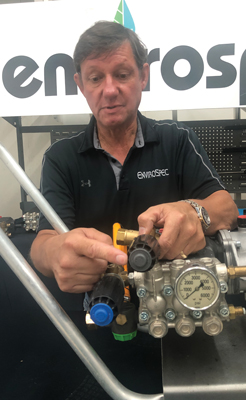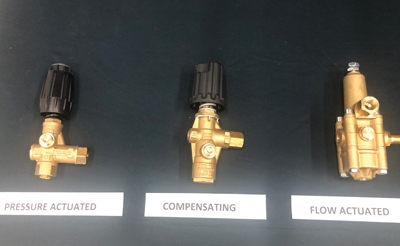
Troubleshooting Unloaders
By Dan Galvin / Published August 2022

When it comes to unloaders, have you ever asked yourself, “So what does this thing do anyway, and why isn’t it working?” Whether you’re new to the pressure washing business or you just needed a reminder, a pressure washer unloader valve diverts water flow through the bypass when the trigger on the gun is depressed. The unloader valve adjusts the pressure of your machine. For you to be able to properly troubleshoot your unloader, you must know which type of unloader you have. In the pressure washing industry, we use three different types of unloaders—pressure actuated, compensating, and flow actuated unloaders.
Pressure actuated, also known as trapped pressure, is the most common unloader valve used on pressure washers. When you release the trigger gun or close the ball valve on the end of your hose, the pressure actuated unloader will trap the pressure in the high-pressure hose and send the water to the bypass. You can tell you have one of these unloaders because you will get a big burst of pressure when you pull the trigger on your trigger gun.

Compensating unloaders are also known as modified pressure unloaders. When you release the trigger gun or close the ball valve on the end of your hose, the pressure trapped in your high-pressure hose is reduced by 25 to 30 percent. This is so when you pull the trigger on your trigger gun, the burst of pressure is reduced and won’t blow you off the ladder like the pressure actuated unloader will. For that in-creased control, you will pay a bit more.
A flow-actuated or flow-type un-loader has NO pressure in your high-pressure hose while the trigger gun or ball valve is closed. This makes it very easy to move the hose around. Because there is no pressure in your hose, you can easily pull the trigger on your trigger gun with one finger and your thumb. These unloaders, while pricier, offer the smoothest operation.
Now that you know what type of unloader you have, we can troubleshoot the most common problems.
Like many of the other parts of the pressure washer, you should first identify other components that could be the problem before you replace your unloader.
Caution—An improperly installed unloader will cause catastrophic damage to your pump! Follow the manufacturer’s installation instructions when installing, or when in doubt, hire a professional to do so.
Pressure Actuated & Compensating Unloaders
Problem: There is low pressure or low flow.
Solution: Check to make sure you are using the correct nozzle size. If the water flow is smooth, make sure the inlet water supply is adequate. I’ve seen crimped hoses and clogged filters, and I’ve even seen a soda can inside a water tank blocking the water supply! Loosen the unloader spring and flush the unloader out to make sure there is no debris in the unloader; then adjust the unloader back to the correct setting. If you release the trigger gun and the pressure goes up to the correct pressure before the unloader goes into the bypass, it’s a water supply problem. If you release the trigger gun and the pressure goes down, check your engine RPMs. If the RPMs are correct, replace the unloader with your backup unloader and test. If the problem persists, begin a pump diagnosis. If the water flow is pulsating, check your pump check valves.
Problem: Unloader cycles on and off when under pressure.
Solution: Check your nozzle size. A nozzle that’s too small for your pressure washer will cause the unloader to cycle on and off when the trigger gun is depressed. Check for a blockage or restriction in your chemical injector, hose, trigger gun, lance, or nozzle. Clean as needed to clear any blockages.
Problem: Unloader cycles on and off when it’s in the bypass.
Solution: Check for water leaks on the high-pressure side of the unloader. Even a small leak from the hose quick connects, or a leaking trigger gun, will cause the unloader to surge on and off.
Problem: When you squeeze the gun trigger, nothing happens or water drips out of the nozzle.
Solution: You could have a clogged nozzle. This is very dangerous as the quick connects are designed not to open while under pressure; and if your nozzle is clogged, you have high pressure trapped in your hose, gun, and lance. With the trigger gun or ball valve closed, loosen the nozzle quick connect on the lance very slowly until the water starts to leak out and relieves enough pressure trapped in the lance so that you can safely remove the nozzle.
Flow Actuated Unloader
Problem: There is low pressure or low flow.
Solution: Check to make sure you are using the correct nozzle size. If the water flow is smooth, make sure the inlet water supply is adequate. Loosen the unloader spring and flush the unloader out to make sure there is no debris in it, and then adjust the unloader back to the correct setting. Flow actuated unloaders’ pressure output is increased as the bolt is screwed out (counterclockwise) from the unloader body. This is the opposite of the procedure followed for a pressure type unloader.
Problem: Unloader cycles while under pressure.
Solution: Check to make sure you are using the correct nozzle size and it’s not clogged. Check that your downstream chemical injector isn’t clogged. Some flow actuated unloaders are gpm (gallons per minute) sensitive, so check that your inlet water supply is adequate, then check your engine RPM’s, and finally check your pump output volume. Clear debris if needed and/or replace the nozzle with an appropriated-sized version.

Problem: Unloader cycles while in bypass.
Solution: Check for water leaks on the output high-pressure side. Make sure you are not using a weep-type trigger gun. Check the bypass port and bypass hose for a blockage or restriction. If using city water, make sure the pressure isn’t too low or too high— minimum pressure is 43 psi and the maximum pressure is 72 psi.
Problem: You squeeze the gun trigger, and there is a delay before it engages.
Solution: Replace the bypass hose with a smaller hose. If you are using a ½-inch hose, reduce it to a 3/8-inch hose, or if you’re using a 3/8-inch hose, reduce to one that is ¼-inch. The flow actuated unloader requires back pressure in the bypass line between 43 psi and 72 psi to work correctly. If the problem still persists, rebuild or replace the unloader.
You can’t PowerThrough!™ your jobs if you aren’t using the correct nozzle. For information on
how to set up your unloader by “nozzling” your pump, go to Envirospec’s tech library article found here: https://envirospec.com/tech-library/unloaders for additional help.
Dan Galvin is EnviroSpec’s president and CEO and has worked in the power washing industry for 20 years. If you have more questions for Dan, contact him at (800) 346-4876 or visit www.envirospec.com.





